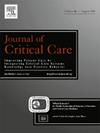脓毒症对痴呆风险的影响:一项基于人群的剂量依赖性队列研究
IF 2.9
3区 医学
Q2 CRITICAL CARE MEDICINE
引用次数: 0
摘要
新出现的证据将败血症相关炎症与痴呆风险联系起来,但复发性败血症发作的剂量依赖性效应仍不清楚。本研究评估了脓毒症是否会增加痴呆风险,并探讨了脓毒症频率与痴呆之间潜在的剂量-反应关系。方法采用台湾全民健康保险研究数据库(2005-2022)进行回顾性队列研究,纳入年龄≥18岁的脓毒症住院患者。一个指标期(2008-2013年)被用来确定先前没有痴呆的患者。采用固定的12个月里程碑期(2014日历年)来评估脓毒症发作的数量。在里程碑时期死亡的患者被排除在外。进行倾向评分匹配以产生平衡良好的败血症组和非败血症组。痴呆和死亡率的随访在里程碑期之后开始,并持续了长达64个月。Cox和Fine-Gray模型被用来解释竞争的死亡风险。结果脓毒症与全因痴呆风险显著增加相关(HR 1.59;95% ci, 1.47-1.72;P & lt;0.0001)。观察到剂量-反应关系:多次脓毒症发作的患者痴呆风险最高(sHR 1.63;95% ci, 1.39-1.91)。血管性痴呆表现出最强的相关性,败血症组的发病率更高(1.2%比0.6%,P = 0.0003)。我们的研究结果提供了强有力的证据,证明败血症与痴呆风险增加之间存在剂量依赖关系,特别是血管性痴呆,即使在调整了相互竞争的死亡率风险之后。本研究解决了以往研究的局限性,不仅采用倾向评分匹配(PSM)来平衡脓毒症组和非脓毒症组之间的混杂因素,而且采用指数期和里程碑期设计来更好地探索潜在的因果关系。这些时期确保痴呆发生在败血症之后,并允许检查败血症发作频率和痴呆之间的剂量-反应关系。此外,这是迄今为止涉及败血症患者的最大规模的研究,提供了比以前的研究更有力的证据,这些研究通常规模较小,缺乏对竞争死亡风险的调整。本文章由计算机程序翻译,如有差异,请以英文原文为准。
Sepsis on dementia risk: A population-based cohort study with dose-dependent analysis
Purpose
Emerging evidence links sepsis-related inflammation to dementia risk, but the dose-dependent effects of recurrent sepsis episodes remain unclear. This study assessed whether sepsis increases dementia risk and explored a potential dose-response relationship between sepsis frequency and dementia.
Methods
We conducted a retrospective cohort study using Taiwan's National Health Insurance Research Database (2005–2022), enrolling patients aged ≥18 years hospitalized with sepsis. An index period (2008–2013) was used to identify patients without prior dementia. A fixed 12-month landmark period (calendar year 2014) was applied to assess the number of sepsis episodes. Patients who died during the landmark period were excluded. Propensity score matching was performed to generate well-balanced sepsis and non-sepsis groups. Follow-up for dementia and mortality began after the landmark period and continued for up to 64 months. Cox and Fine-Gray models were used to account for competing risks of death.
Results
Sepsis was associated with a significantly increased risk of all-cause dementia (HR 1.59; 95 % CI, 1.47–1.72; P < 0.0001). A dose-response relationship was observed: patients with multiple sepsis episodes had the highest dementia risk (sHR 1.63; 95 % CI, 1.39–1.91). Vascular dementia showed the strongest association, with a higher incidence in the sepsis group (1.2 % vs. 0.6 %, P = 0.0003).
Conclusions
Our findings provide robust evidence of a dose-dependent association between sepsis and increased dementia risk, particularly vascular dementia, even after adjusting for competing mortality risks.
Summary
This study addresses the limitations of previous research by not only employing propensity score matching (PSM) to balance confounding factors between the sepsis and non-sepsis groups but also using an index period and landmark period design to better explore potential causal relationships. These periods ensure that dementia onset occurred after sepsis and allow for the examination of dose-response relationship between sepsis episode frequency and dementia. Furthermore, this is the largest study to date involving sepsis patients, providing more robust evidence than prior studies, which were often smaller and lacked adjustments for competing risks of death.
求助全文
通过发布文献求助,成功后即可免费获取论文全文。
去求助
来源期刊

Journal of critical care
医学-危重病医学
CiteScore
8.60
自引率
2.70%
发文量
237
审稿时长
23 days
期刊介绍:
The Journal of Critical Care, the official publication of the World Federation of Societies of Intensive and Critical Care Medicine (WFSICCM), is a leading international, peer-reviewed journal providing original research, review articles, tutorials, and invited articles for physicians and allied health professionals involved in treating the critically ill. The Journal aims to improve patient care by furthering understanding of health systems research and its integration into clinical practice.
The Journal will include articles which discuss:
All aspects of health services research in critical care
System based practice in anesthesiology, perioperative and critical care medicine
The interface between anesthesiology, critical care medicine and pain
Integrating intraoperative management in preparation for postoperative critical care management and recovery
Optimizing patient management, i.e., exploring the interface between evidence-based principles or clinical insight into management and care of complex patients
The team approach in the OR and ICU
System-based research
Medical ethics
Technology in medicine
Seminars discussing current, state of the art, and sometimes controversial topics in anesthesiology, critical care medicine, and professional education
Residency Education.
 求助内容:
求助内容: 应助结果提醒方式:
应助结果提醒方式:


